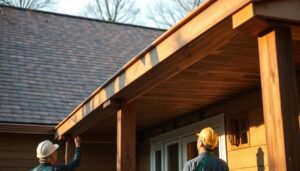Turning your open porch into a cozy, closed-off area can boost your home’s worth. It creates a spot suited for any weather. If you’re eyeing porch enclosure ideas, thinking about a full porch makeover, or wanting to better your outdoor area, we’re here to help. You have lots of choices, from screen to four-season rooms. You can even use clear porch covers from AKON to meet your budget and desires.
For an effective porch close-off, clear vinyl panels work wonders. They keep the space warm and let you see out without blockage. These protect against snow, rain, and wind, keeping the porch comfy through all seasons. With options from 10 to 80 gauge, you can find the right thickness and strength. This means your porch can be enjoyed all year.
Key Takeaways
- Screen rooms are the most cost-effective enclosure option.
- Three season rooms provide comfort from spring to fall but lack heating and cooling support year-round.
- Four season rooms, though more expensive, offer climate-controlled environments.
- Solariums offer floor-to-ceiling views and are designed for all-season use.
- Vinyl panel thickness varies, with 40 gauge being slightly thicker than a credit card.
- Clear vinyl can shrink over time; allow for 1-3% shrinkage during installation.
Understanding the Benefits of Enclosing Your Porch
Adding walls to your porch brings many advantages. It turns a basic outdoor area into something more. You’ll get extra space for all kinds of activities, from eating meals to hanging out or enjoying hobbies. This extra room can add up to 200 square feet of space. It becomes a cozy spot all year, especially with heaters in the cold months.
Another big plus is how it boosts your home’s value. Studies show that porches with walls can make your property worth 10-15% more. It’s a smart way to add space without spending too much. This option can be cheaper and faster than big remodels. Plus, it tends to take less time and money to set up.
Enclosures help protect your porch from bad weather. This keeps your furniture and decorations safe, making them last longer. With special screens, you can block views from outside while still seeing out. This boosts privacy greatly. Screens also let air flow in without letting bugs or rain through.
Having a special outdoor spot is also good for your mind. Enclosed porches make spaces brighter and more welcoming. They let in more sunlight, which can make you feel happier. People with these porches tend to enjoy their homes more, feeling a significant boost in happiness and satisfaction.
Enclosed porches help keep your home safe by providing an extra layer from the outside. This could mean fewer chances for break-ins. They also save you money on energy. By keeping temperatures more steady, they cut down on heating or cooling costs.
| Benefit | Impact |
|---|---|
| Enhanced home value | Increase by 10-15% |
| Extended living space | Up to 200 additional square feet |
| Protection from elements | Increased lifespan of furniture by 20-30% |
| Year-round usability | Comfortable use in all seasons |
| Natural light exposure | Increase by 50% |
| Energy savings | Up to 30% reduction in energy costs |
Putting up an enclosure around your porch is a great move. It makes your home better and more useful. Whether you want a cozy space, a higher home value, or to enjoy the outdoors all year, enclosed porches offer great perks.
Choosing the Right Materials for Your Enclosure
Choosing the right porch enclosure materials is key to making your porch last and work well. Over 65% of new homes now have a porch. They add to outdoor living spaces nicely. Picking the best materials is important for a good return on investment. Homeowners see about a 75% ROI from enclosing their porch.
Different types of porch enclosures offer different advantages. Glass enclosures give you clear views and look sleek. Vinyl panels are cheaper and flexible.
- Vinyl Panels: These are great for lots of homeowners because they’re affordable and easy to keep up. They work in many weather conditions and adapt easily to different seasons.
- Glass Enclosure Options: Glass is very strong and great for all-year use. Double-pane glass also keeps things warm or cool, making it good for varying climates.
When picking porch enclosure materials, think about how they look and work. For example, clear vinyl panels match well with outdoor styles. Double-pane glass makes your space comfy and saves on energy.
Enclosing a porch costs between $500 and $36,000, based on size and materials. Picking the right porch enclosure materials affects your budget too. Some porch screens are good for part of the year. But, options like Scenix windows can make your porch good for more seasons by switching between glass and screens.
Changing screen panels to tempered glass panels lets you use the space all year. The choice between DIY and hiring a pro affects what enclosure you get. Professional installation fits better and is safer, though it might cost more.
In the end, knowing the different types of porch enclosures and choosing the right porch enclosure materials will make your space what you want. It meets your needs and looks how you like, adding value to your home.
Steps to Plan Your Porch Enclosure Project
Start planning your porch enclosure by checking your current porch. Look at the foundation, roof, and surrounding areas that could affect the new space. This first step is key to understand what your porch can handle.
Then, think about what materials to use. Double-glazed glass keeps temperatures steady inside. Polycarbonate roofing lets in light while protecting from weather. Aluminum frames are easy to take care of and last a long time.
Knowing about materials helps you move to design and layout. Think about how the enclosed porch will look and work with your home. Make sure it looks good and is practical too. Here are important steps for designing your porch:
- Check the current structure and its base.
- Pick materials that last and suit the weather.
- Design a space that uses area well and matches your home.
- Use insulated walls and double-glazed windows to save energy.
- Think about heating or cooling for comfort any time of the year.
- Add special touches like clear vinyl for looks and function.
Talk to local authorities or experts about building codes and permits. Rules change by location, so it’s important to check. This ensures your porch meets all legal standards.
Getting help from experts makes the project go faster. They can cut down construction time by a quarter. Plus, putting in an aluminum frame or vinyl curtains right needs skill. This ensures they last and work well.
Finally, decide on a budget. Costs can start at $1,000 for basics and go up for fancier stuff. Remember to add in the little things like bolts and door parts.
| Material | Benefits |
|---|---|
| Double-glazed glass | Maintains indoor temperature, reduces heating/cooling costs |
| Polycarbonate roofing | Lightweight, durable, allows natural light |
| Aluminum frames | Low-maintenance, long-lasting |
| Clear vinyl curtains | Protection against weather, year-round usability |
Following these steps closely will help make your porch project planning successful. By doing this, you’ll end up with a great custom porch enclosure. It will make your home more valuable and your life better.
DIY vs. Hiring a Professional: What’s Best for You?
When you think about enclosing your porch, there are two main paths: Doing it yourself or hiring pros. Which way to go depends on your skills, budget, and how big the project is.
DIY porch enclosures are great for those who love tackling projects. Going the DIY route can save you about 20-30% on what you’d pay a pro for labor. The materials for a DIY screen porch can cost between $2,000 to $5,000. This varies with the size and materials like a Phifer Pet Screen for $180 or Phiferglass GlasShield for $229.
But, DIY can be tough. About 45% of DIYers say not knowing enough makes finishing projects hard. A DIY screen porch takes about 40-80 hours to complete. This depends on the job’s complexity and your experience. And half of these projects are delayed by surprises or not planning well, leading 30% of DIYers to get professional help later.
Choosing a pro for your porch can mean better quality and less hassle. This option costs between $5,000 to $15,000, including work and materials. Pros are best for big changes, like structural work. Around 60% of homeowners prefer a pro for such jobs. Interestingly, 70% of contractors say projects go smoother when they’re involved from the start.
Also, enclosing a porch might mean extra costs for permits and big additions like a roof. Putting on a roof can cost $16 to $30 per square foot, not counting labor, which is $5.35 to $7.55 per square foot. These costs show why many choose pros, as 80% of homeowners are happy with their pro-built screen porches in the end.
Creating a Design that Fits Your Style
Your enclosed porch should feel like a part of your home. It’s about mixing custom designs with stylish enclosures to match your home’s look and its use. Think about adding big, floor-to-ceiling windows. They boost the porch’s beauty and connect you better to outside scenes. Make sure your porch’s design matches your home’s style to keep things consistent.
For a modern vibe, consider modern glass solariums. They’re known for their clean, sharp looks. Using strong fabrics for furniture helps it last longer. And, if you like a cozy, classic style, choose natural materials like wood for that warm feel.
Remember, durability is key. Choose materials that stand up to sunlight and dirt. For example, aluminum furniture is lightweight and strong. If you’re on a tight budget, use bold colors on small, cheap updates like cushions.
A good porch design matters for both looks and use. Adding retractable screens offers comfort away from bugs, letting you enjoy the open air. If your porch serves many purposes, look for furniture that has dual uses, such as sofas that turn into beds.
Good decor makes a big difference on porches. A big rug adds definition and comfort to your seating setup. Adding plants brings the feel of nature closer. And, the right color scheme can turn your porch into a peaceful retreat.
Keep these tips in mind to make your porch stylish yet practical. Your porch can be eclectic or matched perfectly with your home. The aim is to make it an enjoyable part of your living space.
Essential Tools and Equipment for the Project
Are you thinking about building a porch by yourself or with professionals? Make sure you have the right tools for a porch project. This guide covers everything from simple tools to complex equipment. This makes sure your project goes without any problems.
Start with some basic DIY porch tools like a tape measure, hammer, screwdriver set, and level. These are for making sure your project is accurate. A drill and lots of drill bits will also make work easier.
If you’re aiming for a 3-season or 4-season room, you’ll need some extra tools. Tools like a circular saw and reciprocating saw help cut materials. A miter saw is great for angled cuts. Also, a nail gun will greatly speed up your work.
| Project Type | Materials Cost | Labor Cost | Total Cost |
|---|---|---|---|
| Screened Deck | $1,000 – $3,000 | $2,000 – $4,000 | $3,000 – $7,000 |
| 3-Season Room | $5,000 – $10,000 | $4,000 – $8,000 | $9,000 – $18,000 |
| 4-Season Room | $10,000 – $20,000 | $8,000 – $15,000 | $18,000 – $35,000 |
| Solarium | $20,000 – $40,000 | $15,000 – $25,000 | $35,000 – $65,000 |
Don’t forget about safety gear. Make sure to wear safety glasses, gloves, and ear protection when using power tools. These keep you safe from injuries. Also, using a strong ladder and scaffolding helps you reach high places safely.
It also pays to have good tools for building a porch. With a well-stocked toolbox, your project will run smoother. This is true whether you’re working alone or with a contractor.
Maintenance Tips for Your Enclosed Porch
Keeping your enclosed porch beautiful and long-lasting takes regular work. By following these maintenance tips for your enclosed porch, you can stop damage and make the area welcoming all year. Knowing what your porch materials need is the first step.
Vinyl and glass are popular for porches because they last long and are easy to take care of. Clean them often with mild soap and water to keep them looking good. Fixing any small cracks or chips in glass quickly can avoid big problems later. This regular care helps keep your porch strong and looking great.
It’s important to get your porch ready for changes in weather to avoid damage. In the cold months, good insulation keeps it warm and might let you use it 50% more. When it’s hot, double-glazed windows can cool the space, saving 10-30% on energy. Keeping up with these cleaning tasks and ways to stop damage will make your porch a great part of your home.




